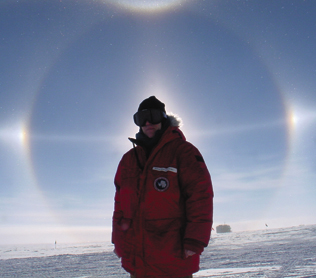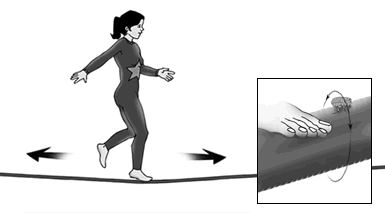In 1998, Nima Arkani-Hamed found himself pondering one of the conundrums of modern physics: why is gravity so much weaker than the other fundamental forces?
Surrounded by massive objects like falling apples, orbiting moons, and our own occasionally clumsy bodies, we don't think of gravity as weak. Compared to electromagnetism, however-or the aptly named strong force that binds quarks, or even the "weak" force that governs some forms of radioactive decay-gravity is feeble. A pin on a tabletop is held down by the gravity of the entire Earth; a toy magnet snaps it up.
|
|
| An aerialist on a tight wire can travel in only one dimension, forward and back. A flea on the wire finds a "rolled-up" second dimension. |
Particle accelerators have shown that electromagnetism and the weak force are aspects of one electroweak force; they will soon attain enough energy to observe "grand unification" with the strong force. Gravity too is unified with these forces, but because it is weaker by scores of orders of magnitude, accelerators can never achieve the colossal energies needed to see its unification-unless Nima Arkani-Hamed is right.
With his colleagues Savas Dimopoulos of Stanford and Gia Dvali of New York University, Arkani-Hamed, now of UC Berkeley and Berkeley Lab's Physics Division, proposed that gravity may function in more than three spatial dimensions. If so, we experience only part of its effect.
In a three-dimensional world, the strength of attraction is squared when the distance between two masses is halved (by the inverse-square law we learned in school). In four dimensions, however, strength varies as the cube, in five dimensions as the fourth power, and so on. Maybe gravity isn't weak at all; maybe it only seems that way.
How big would extra dimensions have to be? For gravity to equal the other forces at a hundred-thousandth of a trillionth of an inch (the electroweak scale), one extra dimension would have to be as big as the distance between the Earth and the sun. Two extra dimensions need extend only about a millimeter, however, and the more extra dimensions there are, the smaller they can be.
Additional dimensions are surprisingly easy to overlook. Consider a performer on a high wire, confined to a single dimension, forward and back. A flea can move around the wire as well as along it, experiencing an extra dimension.
Dimensions tinier than subatomic particles, like those invoked by superstring theory, would be impossibly hard to probe. On the other hand, with a single extra dimension of astronomical size, gravity would have collapsed the solar system. Between these extremes falls the millimeter scale.
Curiously, gravity has yet to be measured at much less than a millimeter. To calculate the gravitational attraction between two masses, one of them must be smaller than the distance separating them-easy with falling apples and orbiting moons but impossible with, say, poppy seeds.
Moreover, "as test masses get smaller, residual electromagnetic effects come into play and swamp gravitation," says Arkani-Hamed. "Nobody knows what the real force of gravity is at short distances."
That situation may soon change. Clever tabletop experiments test gravity at ever shorter distances. If they should observe a sudden startling increase in its strength at short distances, extra dimensions are the logical suspect.
Even more dramatic effects could be produced in particle accelerators such as the Large Hadron Collider now under construction in Europe. If some of the particles that carry gravity escape into extra dimensions, high-energy collisions would show a mass-energy deficit, apparently violating the first law of thermodynamics. Conversely, regions of immensely strong gravity might be created at short range-miniature black holes that quickly evaporate, releasing a shower of radiation "from nowhere."
Indeed, if our three-dimensional universe resides on a "wall" in a larger "bulk" of multiple dimensions, our world might be just one of many worlds, or it might be folded upon itself many times. Distant reaches of the cosmos and whole other universes might lie less than a millimeter away.
"In this view, 'dark matter' might be just ordinary matter,"
Arkani-Hamed suggests, "because the light from a star on a fold only
one millimeter away might have to travel billions of light years 'along
the wall' to reach us. Although we feel its gravity, we haven't seen it
yet."
A wide range of other puzzles might be solved if extra dimensions are
real. And if we do the experiments, Arkani-Hamed says, "we have a
good chance of seeing evidence for or against these ideas in the next
ten years."
As recently as 1996 one science-writing pessimist was predicting the
"end of science," asserting that what isn't already known never
can be; his assumption has proved spectacularly wrong. Arkani-Hamed is
one of several young theorists who suspect there may be more dimensions
of space than meet the eye. By offering to solve some of physics' most
intractable problems, their fresh ideas have revitalized science.
Crystalline Heavens
|
|
 |
Engineer Gerald Przybylski of the Physics Division is a Berkeley Lab researcher who has made numerous trips to the South Pole to help build the AMANDA array, a neutrino "telescope" consisting of strings of detectors suspended deep in the Antarctic ice. One balmy polar day last summer (winter in the Northern Hemisphere), Przybylski photographed his German colleague Ralf Wischnewski against a spectacular display of celestial art.
Wischnewski's head, conveniently blocking the sun, is ringed by a halo and flanked by sun dogs, where the halo is crossed by a parhelic circle. A sun pillar climbs straight up to an upside-down rainbow (upper tangent arc) crowning the whole. Sun dogs, so-called for their tails streaming away from the sun, are separated from it by 22 degrees, the radius of the circular halo to which the eponymous tangent arc is tangent. The parhelic circle passes through the center of the sun and sometimes circles the entire sky at the sun's elevation. These effects and others appear when the sun is low and the atmosphere is filled with drifting ice crystals.
Ice crystals are hexagonal shapes that reflect and refract light like countless tiny prisms; long-wavelength red light is bent less than short-wavelength blue light, so halos, sun dogs, and arcs are reddish to sunward, with their outward edges blue.
When the sun is near the horizon, its rays refract from the inside of crystals drifting down horizontally, creating bright sun dogs. Halos, however, are formed mostly by reflections from the outside of randomly oriented crystals, while both internal refraction and external reflection contribute to pillars. The tangent arc is formed by refraction in six-sided rods of ice shaped like pencils, not plates.
Low ice crystals are common in polar regions, and halo displays are easier to see when the sun is near the horizon, but you don't have to travel to the far north or the far south to see these lovely effects; any conveniently oriented cirrus cloud will do.
For excellent simulations and diagrams of these and other atmospheric effects, visit http://www.sundog.clara.co.uk/halo/halosim.htm - end -
|
|||||||||
